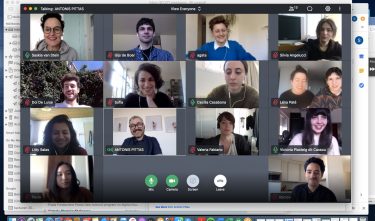How does one write about design in times of a lockdown due to a planetary pandemic? Which form follows disfunction?
Should this column address the cultural loss in the closing of the glass factory in Leerdam, the museums which will never reopen their doors or how grim the future of our cultural landscape looks? Should I share the amazement I feel witnessing with what ‘bang’ Instagram TV (IGTV) is manifesting itself as the platform for cultural exchange, dialogue and the sharing of stories? Or all the questions surrounding the material, programmatic or long term consequence of ‘designing for the 1,5m society’? And what about the magnifying effect the covid-19 has exposing the injustice and inequality in our financial system, who is capitalising on the virus for political gain or how this crisis relates to the other major crisis namely that of our climate? As we situate ourselves in the middle of a global glitch, I chose to keep this column small and close to my day to day reality, some reflections:
In the beginning of this academic year, in September 2019, I became headmaster of the Critical Inquiry Lab, a Master department at Design Academy Eindhoven. Education has given me the opportunity to expand my thinking around the responsibilities we have towards the future generation. Design no longer only follows form, it can follow anything, so what do you want to follow and where do you want to make a difference? Much to the dislike of those in power, we are in an immense transition — change is due, and change is coming. We can blame global capitalism for its unhinging capacity, but it is rooted in so much more — religion, culture, gender, history, language and so on.
All these constructs are up for critical revisioning and reinvigoration. Design as research and the curatorial aspects of making public, remain the foundation of this Master’s. But the emphasis lies on students developing their own autonomous, precise, well-researched position through experiment, rigour and reflexivity. It is important to not simply perpetuate the biases, semantics and material reality of how the world is organised at the moment, but to deconstruct it in a way that makes this become visible*. Yet how can all these ambitions be manifested in the seismic shift we currently undergo; the shift from collective class education to online conversations in the confinement of our homes? How can technological platforms produce meaningful pedagogical experiences? Which reductive aspects are introduced in being separated in body and place, while being connected through a screen? Which responsibilities does an educator have beyond the education, as many of our international students are separated from friends and families? Adapting the whole curriculum to an online environment as demanded from all parties involved. The long-term consequences remain to be seen but, for now, it results in sharing more time and conversation together. I am amazed by the students’ strength, flexibility and their capacity to deepen and articulate their thought and ideas under these precarious circumstances.
Like many in the cultural field, my practice is changing since many of the cultural events in which I am engaged have been postponed or cancelled. As a result, we, as humans but certainly as cultural practitioners, do what we do best. We adapt, shift, reimagine and make the ‘New Normal’ productive. After my first online moderation, a debate with young fashion designers, it dawned on me. This crisis seems to have brought us nearer to ourselves and a transpersonal aspect closer to the design profession. Design is always a model and therefore is always distant.
 1
1
The current conditions have freed us from the forced search of the service and meaning of the discipline. The avantgarde, the early adaptors are constantly pushing the envelope and expanding what we consider the boundaries of the profession. This attitude of stretching and permeating design into other transdisciplinary realms, and while doing so eagerly legitimising its role in society and its added value, if this ever seemed forced has now become fluid.
Some sort of elasticity draws the professional skills to personal empowerment and engagement. In my observation, the young designers I spoke to seemed less interested in fashion, which has become more about identity, instead they focused on design as functionality and/or technology, which has seemed to liberate them. From issue to matter. A new Mode d’emploi is emerging. In their case, resulting in the development of (paid) online sewing courses, reconnecting to the needs of their local community, experimenting with alternative ways of producing (for instance facial masks), the sense of fulfilment felt by being in demand, taking the time to redefine the financial structure of their practice, or emphasising the storytelling aspect in a design. All in all beside the tragedy and loss, this global glitch also hints on possible alternative ways of organising our planetary systems.
Saskia van Stein, DDA jury member and committee chair in the category ‘Young Designer’
*quote taken from an interview with Nadine Botha for Design Academy Eindhoven.